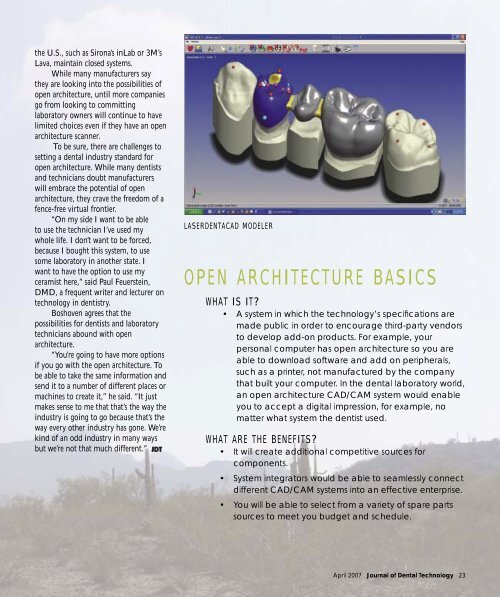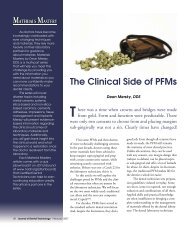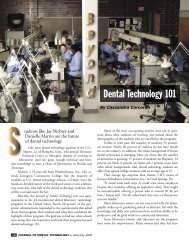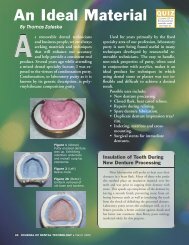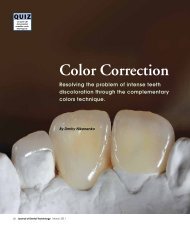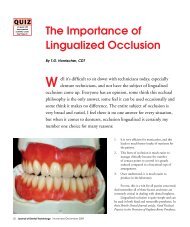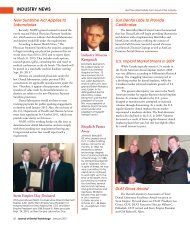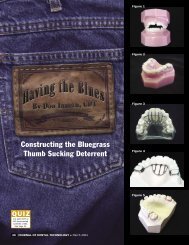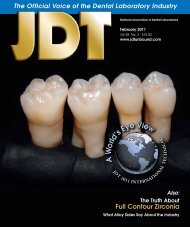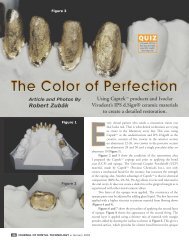20 Journal of Dental Technology April 2007 - JDT Unbound
20 Journal of Dental Technology April 2007 - JDT Unbound
20 Journal of Dental Technology April 2007 - JDT Unbound
You also want an ePaper? Increase the reach of your titles
YUMPU automatically turns print PDFs into web optimized ePapers that Google loves.
the U.S., such as Sirona’s inLab or 3M’s<br />
Lava, maintain closed systems.<br />
While many manufacturers say<br />
they are looking into the possibilities <strong>of</strong><br />
open architecture, until more companies<br />
go from looking to committing<br />
laboratory owners will continue to have<br />
limited choices even if they have an open<br />
architecture scanner.<br />
To be sure, there are challenges to<br />
setting a dental industry standard for<br />
open architecture. While many dentists<br />
and technicians doubt manufacturers<br />
will embrace the potential <strong>of</strong> open<br />
architecture, they crave the freedom <strong>of</strong> a<br />
fence-free virtual frontier.<br />
“On my side I want to be able<br />
to use the technician I’ve used my<br />
whole life. I don’t want to be forced,<br />
because I bought this system, to use<br />
some laboratory in another state. I<br />
want to have the option to use my<br />
ceramist here,” said Paul Feuerstein,<br />
DMD, a frequent writer and lecturer on<br />
technology in dentistry.<br />
Boshoven agrees that the<br />
possibilities for dentists and laboratory<br />
technicians abound with open<br />
architecture.<br />
“You’re going to have more options<br />
if you go with the open architecture. To<br />
be able to take the same information and<br />
send it to a number <strong>of</strong> different places or<br />
machines to create it,” he said. “It just<br />
makes sense to me that that’s the way the<br />
industry is going to go because that’s the<br />
way every other industry has gone. We’re<br />
kind <strong>of</strong> an odd industry in many ways<br />
but we’re not that much different.”<br />
LaserdentaCAD Modeler<br />
Open Architecture Basics<br />
What is it<br />
• A system in which the technology’s specifi cations are<br />
made public in order to encourage third-party vendors<br />
to develop add-on products. For example, your<br />
personal computer has open architecture so you are<br />
able to download s<strong>of</strong>tware and add on peripherals,<br />
such as a printer, not manufactured by the company<br />
that built your computer. In the dental laboratory world,<br />
an open architecture CAD/CAM system would enable<br />
you to accept a digital impression, for example, no<br />
matter what system the dentist used.<br />
What are the benefits<br />
• It will create additional competitive sources for<br />
components.<br />
• System integrators would be able to seamlessly connect<br />
different CAD/CAM systems into an effective enterprise.<br />
• You will be able to select from a variety <strong>of</strong> spare parts<br />
sources to meet you budget and schedule.<br />
<strong>April</strong> <strong>20</strong>07 <strong>Journal</strong> <strong>of</strong> <strong>Dental</strong> <strong>Technology</strong> 23


